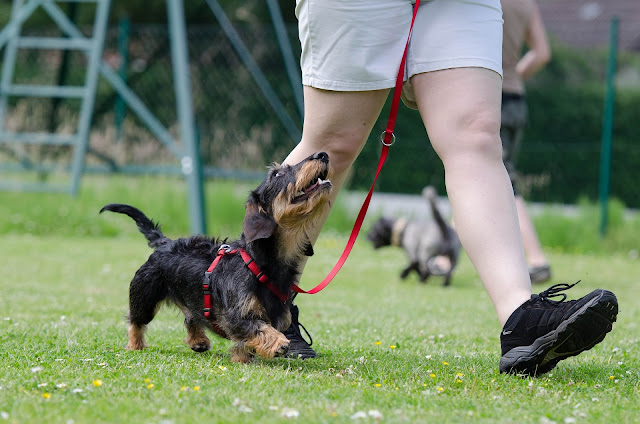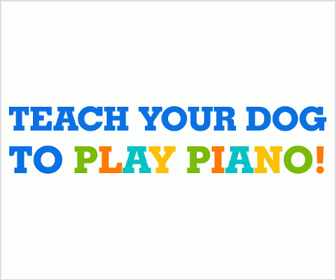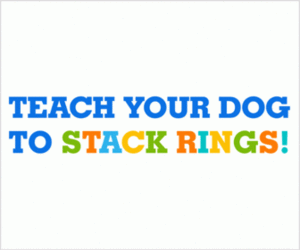Training a dog can be a rewarding experience for both the owner and the pet. However, it requires patience, consistency, and a solid understanding of the training process. In this guide, we will discuss the essential steps to train your dog, from basic obedience commands to advanced tricks
Understanding Dog Behavior
Before starting any training, it is crucial to understand your dog's behavior. Dogs are pack animals, and they have a natural instinct to follow a leader. As an owner, you need to establish yourself as the pack leader to gain your dog's respect and trust. Dogs also respond well to positive reinforcement, such as praise, treats, and toys.
Setting Up a Training Plan
To train your dog effectively, you need to create a training plan. Set specific goals and timelines for each command or trick. Start with basic obedience commands, and gradually move to more advanced techniques. Consistency is essential in training, so make sure to practice every day.
Basic Obedience Training
Sit
Teaching your dog to sit is one of the easiest commands. Start by holding a treat close to your dog's nose, then move your hand up. Your dog will follow the treat, and his butt will naturally lower to the ground. Once your dog is in the sitting position, say the word "sit" and give him the treat.
Stay
Once your dog has learned to sit, you can teach him to stay. Start with your dog in the sitting position, then open your hand and say "stay." Take a step back and wait for a few seconds. If your dog stays in the sitting position, reward him with a treat and praise.
Come
Teaching your dog to come when called is an essential command for safety. Start by saying your dog's name, then say "come" and pat your thigh. When your dog comes to you, reward him with a treat and praise.
Heel
Teaching your dog to walk beside you without pulling on the leash is crucial for leash training. Start by holding a treat close to your dog's nose, then start walking. When your dog walks beside you without pulling, reward him with a treat and praise.
4. Positive Reinforcement Techniques
Positive reinforcement is the most effective training technique for dogs. It involves rewarding your dog with treats, toys, or praise when he behaves correctly. Positive reinforcement creates a positive association with the desired behavior, making your dog more likely to repeat it.
5. House Training
House training is one of the most challenging aspects of training a dog. It requires patience and consistency. Start by establishing a routine for feeding and potty breaks. Take your dog outside after every meal, playtime, and nap. When your dog goes potty outside, reward him with praise and treats.
Leash Training
Leash training is a critical aspect of dog training. It not only helps to control your dog but also ensures their safety while out on walks. Here are some steps to follow when leash training your dog:
- Introduce the leash gradually - Begin by allowing your dog to get used to the feel of the leash. Let them sniff and play with the leash while it's on the floor. This helps them to become comfortable with it.
- Attach the leash - Once your dog is comfortable with the leash, attach it to their collar or harness. Allow them to walk around with the leash dragging behind them, but keep a close eye on them to avoid any accidents.
- Start walking - Start walking slowly and allow your dog to explore their surroundings. If your dog starts pulling on the leash, stop walking and stand still. Wait for your dog to come back to your side before continuing.
- Use positive reinforcement - When your dog walks beside you without pulling, reward them with treats, praise, or toys. This reinforces the desired behavior and makes them more likely to repeat it.
- Be consistent - Consistency is key when leash training your dog. Practice walking on the leash every day, and be patient with your dog. It may take some time for them to learn to walk calmly on the leash.
- Avoid punishment - Punishing your dog for pulling on the leash is not an effective training technique. It can cause fear and anxiety, making leash training more challenging. Instead, focus on positive reinforcement and rewarding good behavior.
Remember, leash training takes time and patience. With consistent practice and positive reinforcement, your dog can learn to walk calmly on the leash and enjoy their daily walks with you.
Crate Training
Crate training is a popular method of dog training that involves using a crate as a safe and comfortable space for your dog. Here are some steps to follow when crate training your dog:
- Choose the right crate - Choose a crate that is the right size for your dog. It should be large enough for them to stand up, turn around, and lie down comfortably.
- Introduce the crate gradually - Introduce your dog to the crate gradually. Allow them to explore it, and place their favorite toys and treats inside to make it more inviting.
- Use positive reinforcement - When your dog enters the crate voluntarily, reward them with treats, praise, or toys. This reinforces the idea that the crate is a positive and safe space.
- Gradually increase the time spent in the crate - Start by leaving your dog in the crate for short periods of time, gradually increasing the time as they become more comfortable. Always ensure they have access to water and toys.
- Use the crate for sleeping - Use the crate as your dog's sleeping space at night. This helps to establish a routine and reinforce the idea that the crate is a safe and comfortable space.
- Avoid using the crate for punishment - Never use the crate as a form of punishment. It should always be a safe and positive space for your dog.
Remember, crate training can take time and patience. With consistent practice and positive reinforcement, your dog can learn to see the crate as their safe and comfortable space, making them feel more secure and less anxious.
Socialization Training
Socialization training is an essential aspect of dog training that involves exposing your dog to different people, animals, and environments. It helps your dog to develop social skills and learn to be comfortable in a variety of situations. Here are some steps to follow when socializing your dog:
- Start early - Begin socializing your dog as early as possible. Puppies have a critical socialization period between 3 and 14 weeks, during which they are most receptive to new experiences.
- Expose your dog to different people - Introduce your dog to different people, including children, adults, and seniors. This helps them to become comfortable around people of all ages and sizes.
- Introduce your dog to other dogs - Allow your dog to interact with other dogs in a safe and controlled environment. This helps them to learn how to communicate with other dogs and avoid aggressive behavior.
- Visit new places - Take your dog to new places, such as parks, beaches, and other public areas. This helps them to become comfortable in different environments and around new sounds and smells.
- Use positive reinforcement - When your dog behaves well in social situations, reward them with treats, praise, or toys. This reinforces positive behavior and makes them more likely to repeat it.
- Be patient - Socialization training takes time and patience. Your dog may be hesitant or anxious in new situations, but with consistent practice and positive reinforcement, they can learn to become more confident and comfortable.
Remember, socialization training is crucial for your dog's well-being and helps them to develop social skills that will benefit them throughout their life. By exposing them to new experiences and using positive reinforcement, you can help your dog become a well-adjusted and happy member of your family.
Advanced Training Techniques
Advanced training techniques are used to teach dogs more complex behaviors and commands beyond basic obedience training. These techniques require more time, patience, and skill from the dog owner. Here are some advanced training techniques to consider:
- Clicker Training - Clicker training involves using a clicker device to make a clicking sound when your dog performs a desired behavior. This helps your dog to understand what behavior is being rewarded.
- Target Training - Target training involves teaching your dog to touch a specific object with their nose or paw. This can be useful in teaching them to open doors, turn off lights, or perform other tasks.
- Agility Training - Agility training involves teaching your dog to navigate an obstacle course. This can improve their coordination and focus.
- Search and Rescue Training - Search and rescue training involves teaching your dog to search for and locate missing people. This can be a useful skill in emergency situations.
- Nose Work Training - Nose work training involves teaching your dog to use their sense of smell to locate hidden objects. This can be a fun and stimulating activity for your dog.
- Protection Training - Protection training involves teaching your dog to protect you or your property on command. This can be a useful skill for personal protection or security purposes.
Remember, advanced training techniques should only be attempted by experienced dog trainers or under the supervision of a professional. These techniques can be challenging for both the dog and owner and require patience, consistency, and positive reinforcement. With the right approach and dedication, advanced training techniques can help you and your dog develop a stronger bond and achieve impressive results.
Common Training Mistakes to Avoid
Training your dog can be a rewarding experience, but it's important to avoid common mistakes that can hinder your progress. Here are some common training mistakes to avoid:
- Inconsistency - Consistency is key when it comes to training your dog. If you're not consistent in your commands, rewards, and discipline, your dog may become confused and may not learn as quickly.
- Lack of Patience - Training your dog takes time and patience. If you become frustrated or lose your temper, your dog may become anxious or fearful and may not learn as effectively.
- Using Physical Punishment - Physical punishment, such as hitting or spanking, can be harmful to your dog and may cause them to become fearful or aggressive. It's important to use positive reinforcement techniques, such as treats and praise, to encourage good behavior.
- Not Socializing Your Dog - Socialization is an essential part of training your dog. If you don't expose them to different people, animals, and environments, they may become anxious or aggressive in new situations.
- Overtraining - Overtraining your dog can be counterproductive and may cause them to become bored or frustrated. It's important to give your dog breaks and make training sessions fun and engaging.
- Lack of Clear Communication - Clear communication is essential when training your dog. If you're not clear in your commands or body language, your dog may not understand what you're trying to teach them.
Remember, training your dog takes time, patience, and dedication. By avoiding these common mistakes and using positive reinforcement techniques, you can build a strong bond with your dog and achieve successful results.
Conclusion
Training your dog is an important part of being a responsible pet owner. Whether you're teaching them basic obedience commands or advanced skills, it's essential to use positive reinforcement techniques, be patient, and remain consistent in your training. By avoiding common training mistakes and using effective training techniques, you can help your dog develop good behavior, build their confidence, and strengthen the bond between you and your pet. Remember, training your dog takes time and dedication, but the rewards are well worth it. With patience and practice, you and your dog can achieve great success in training and have a happy and fulfilling life together.
FAQs
- Q: How long does it take to train a dog? A: The time it takes to train a dog depends on a variety of factors, such as their breed, age, and temperament, as well as the specific skills you're teaching them. However, most basic obedience skills can be taught within a few weeks to a few months with consistent training.
- Q: Is it ever too late to train a dog? A: It's never too late to train a dog. Dogs of all ages can benefit from training, and even older dogs can learn new skills and behaviors with patience and practice.
- Q: What if my dog doesn't respond to training? A: If your dog doesn't seem to be responding to your training efforts, it's important to evaluate your approach and techniques. Consider seeking the help of a professional dog trainer, who can provide personalized guidance and support.
- Q: Can I train my dog on my own, or do I need a professional trainer? A: While it's possible to train your dog on your own, working with a professional trainer can be beneficial, especially for more complex or advanced training techniques. A professional trainer can provide guidance, support, and personalized training plans to help you and your dog achieve your training goals.
- Q: Can I train my dog using punishment or dominance-based techniques? A: Punishment or dominance-based training techniques can be harmful to your dog and may not be effective in the long run. It's important to use positive reinforcement techniques, such as treats and praise, to encourage good behavior and build a strong bond with your dog.







.png)

.png)
.png)
.png)
















